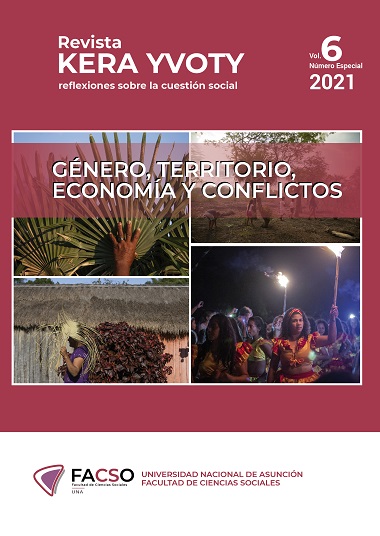Abstract
The research sought to describe the migration experience from the countryside to the city of women from Bañado Sur de Asunción in 2019, through a qualitative, descriptive, observational design; and through the perspective of migrant women with elements of the empirical reality. From the critical perspective, it is possible to characterize the migratory phenomenon in relation to the problem of land in Paraguay. This is understood as a broken social relationship through these forced displacements that finally obey to changes produced within the economic structure of production.
The sociodemographic characteristics of migrant women that concomitantly intertwine social inequalities in the urban and rural environments, leading them to labor precariousness in both environments, become evident.
These women had previously migrated to other geographic areas and not directly from their communities of origin to Bañado Sur; that is, there was a process of rural-rural and rural-urban migration.
Six moments of transit were identified: 1) the present time, in the urban area as the last settlement 2) before migration, where life in the rural area developed before the arrival in the cities 3) the day of migration, which constitutes an angular event in the women's lives 4) the migratory moment of transit from the community of origin, which made it possible to observe mobility in its social context 5) the moment of arrival, which configures the conditions in which the cities receive the women, the first resettlement; and finally 6) the transition in the city and what it entails to start life with other parameters, codes and languages, which is still an unfinished process, since it is multidimensional.
Translated with www.DeepL.com/Translator (free version)
References
Antonelli, R. A. (2016). La periferia de la periferia: mujeres migrantes en el conurbano bonaerense. http://conferencias.unc.edu.ar/index.php/gyc/4gys/paper/viewFile/4397/1476
Carpinetti, J. (2017). Teorías de las migraciones, paradigmas epistemológicos en las ciencias sociales y condiciones sociales de producción. Cuadernos FHyCS-UNJu - Universidad Nacional de Jujuy, (52), 59-79.
Coronel, B. (1994). El movimiento Barrial en Paraguay Un nuevo actor social. Documento de trabajo N° 65 Programa de Estado y Sociedad. Base Investigaciones Sociales.
Equipo Arquidiocesano de Pastoral Social. (1986). Lucha y tierra urbana en Asunción. El derecho de los pobres a la tierra y la vivienda, Araverá.
Falú, A. (2018). Espacios metropolitanos igualitarios. Barcelona: asociación mundial de las grandes metrópolis.
Gómez Walteros, J. A. (2010). La migracion Internacional: Teorias y enfoques, una mirada actual. http://www.redalyc.org/articulo.oa?id=165014341004, 13(26), 81-99.
Henault, M. (1973). La mujer y los cambios sociales. En H. M. Morton, Las Mujeres dicen Basta (p. 13-40). Ediciones Nueva Mujer.
Hernández, R., Fernández, C., & Baptista, P. (2006). Metodología de la investigación (4ª ed.). Mc Graw Hill.
Marini, R. M. (1993). El desarrollo del capitalismo mundial y su impacto en América Latina. El desarrollo del capitalismo mundial y su impacto en América Latina Archivo de Ruy Mauro Marini. www.archivochile.com/Ideas_Autores/maurinirm/03al/maurini_al00002.pdf
Muriel del Cueto, C. (s.f.). Un estudio sobre la acción cultural en dos barrios del Gran Buenos Aires.
Ocampo, M. S. (2015). Del campo a la periferia de la ciudad, la omnipresente sombra de la violencia. Campesinos desplazados forzados en Colombia caminan de la mano del eterno retorno a la violencia. vulneracion y potencia de vida. http://www.scielo.br/scielo.php?pid=S0103-65642015000200161&script=sci_abstract&tlng=es. 83
Oddone, H. (2011). Impactos de la migración en el desarrollo nacional: una aproximación histórico-social. Migrantes Perspectivas (criticas) en torno a los procesos migratorios del Paraguay (p. 60-82). Ápé Paraguay.
Osorio, F. (1993). La violencia del silencio. Desplazados del campo a la ciudad. Consultoría para los Derechos Humanos y el Desplazamiento, CODHES. Pontificia Universidad Javeriana, Facultad de Ciencias Económicas y Administrativas.
Palau, T. (2011). El marco expulsivo de la migración paraguaya. Migrantes Perspectivas (criticas) en torno a los procesos migratorios del Paraguay (p. 40-59). Ápe Paraguay.
Palau, T., & Heikel, M. V. (2016). Los campesinos el Estado y las empresas en la frontera agrícola (2a ed.). Base Investigaciones Sociales.
Quiroga Diaz, N. (2009). Economía feminista y economía social. Contribuciones a una critica de las nuevas políticas de combate a la pobreza. Iconos. Revista de Ciencias Sociales, 77-89.
Riquelme, Q., & Vera, E. (2015). Agricultura campesina, agronegocio y migración. CDE.
Salazar Cruz, C. (2000). La relación población-recursos en la periferia urbana. Una experiencia teórico-metodológica. Estudios Demográficos y Urbanos. www.redalyc.org/articulo.oa?id=31204505, 641-64.
Sánchez Hernández, V. (2014). Metodología de la investigación, bioestadística y bioinformática en ciencias médicas y de la salud. McGraw-Hill Interamericana.

This work is licensed under a Creative Commons Attribution 4.0 International License.
Copyright (c) 2021 Belinda García




